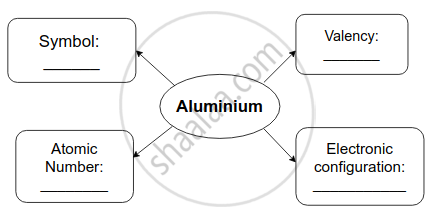Advertisements
Advertisements
Question
Explain the difference between Bayer’s process and Hall’s process by explaining the Bayer’s process.
Solution
- Difference between Bayer’s process and Hall’s process:
In Bayer’s process, aluminium ore is heated with concentrated caustic soda while in Hall’s process, it is heated with aqueous sodium carbonate to obtain water-soluble sodium aluminate. In Bayer’s process, the solution of sodium aluminate is diluted with water to obtain aluminium hydroxide while in Hall’s process, sodium aluminate is converted to aluminium hydroxide by reaction with CO2. - Bayer’s process:
- In this process, the bauxite ore is first crushed and then it is leached by heating with hot concentrated caustic soda (NaOH) solution under high pressure for 2 to 8 hrs at 140 to 150 °C in a tank called a digester.
- Aluminium oxide, being amphoteric in nature, dissolves in an aqueous NaOH solution, forming water-soluble sodium aluminate.
\[\ce{\underset{\text{oxide}}{\underset{\text{Aluminium}}{Al2O3.2H2O_{(s)}}} + \underset{\text{hydroxide}}{\underset{\text{Sodium}}{2NaOH_{(aq)}}} -> \underset{\text{aluminate}}{\underset{\text{Sodium}}{2NaAlO_{2(aq)}}} + \underset{\text{Water}}{3H2O_{(l)}}}\] - The iron oxide present in the gangue does not dissolve in an aqueous NaOH solution and is separated by filtration. However, silica from the gangue dissolves in an aqueous NaOH solution forming water-soluble sodium silicate.
- The solution of sodium aluminate is diluted with water and then cooled to 50 °C. This gives aluminium hydroxide as a precipitate.
\[\ce{\underset{\text{aluminate}}{\underset{\text{Sodium}}{NaAlO_{2(aq)}}} + \underset{\text{Water}}{2H2O_{(l)}} -> \underset{\text{hydroxide}}{\underset{\text{Sodium}}{NaOH_{(aq)}}} + \underset{\text{hydroxide}}{\underset{\text{Aluminium}}{Al(OH)_3}\downarrow}}\] - The aluminium hydroxide is then filtered, washed, dried and calcined by heating at 1000 °C to get pure aluminium oxide, called alumina.
\[\ce{\underset{\text{hydroxide}}{\underset{\text{Aluminium}}{2Al(OH)_{3(s)}}} ->[heat][1000 °C] \underset{\text{oxide}}{\underset{\text{Aluminium}}{Al2O_{3(s)}}} + \underset{\text{vapour}}{\underset{\text{Water}}{3H2O_{(g)}}}}\]
APPEARS IN
RELATED QUESTIONS
In the extraction of aluminium: Name the process of concentration of bauxite.
Name two metals which are found in nature in the free state.
In the extraction of aluminium: Why is it necessary to replace anodes time to time?
How is zinc extracted from its carbonate or (calamine)? Explain with equations.
Name one ore of aluminium. Name the aluminium compound present in this ore and write its chemical formula.
Name the electrode at which aluminium metal is produced.
The two metals which can be extracted just by heating their sulphides in air are:
(a) sodium and copper
(b) copper and aluminium
(c) potassium and zinc
(d) mercury and copper
Aluminum is used in thermite welding:
what is ignition mixture?
Distinguish between ‘roasting’ and ‘calcination’. Which of these two is used for sulphide ores and why?
Give the chemical formula of :
Bauxite
Name the following:
The process of heating a substance very strongly in such a way that it does not combine with oxygen.
The following questions relate to the extraction of aluminium by electrolysis.
Explain why it is necessary to renew the anode periodically.
Name the following:
The process of heating an ore to a high temperature in the presence of air.
Which one of the following is not true of metal :
Metals are malleable and ductile
Complete flow chart given below.

Read the following passage and answer the questions.
According to the reactivity series, zinc is more reactive than iron, iron is more reactive than silver. During study of this, a student dipped the iron nails in silver nitrate solution.
- What is reactivity series?
- What will happen when iron nails are dipped in silver nitrate solution?
- Which type of reaction happens when iron metal reacts with silver nitrate solution?
- What will happen if a zinc rod is used instead of iron nail?
Explain in brief electrolytic reduction of alumina with a neat labelled diagram.
Observe the figure and answer the following.

- Write the name of the method.
- What is used as anode and cathode in this method?
- Write the molecular formula and use of cryolite.
- Write anode reaction.
- Write cathode reaction.
During extraction of metals, electolytic refining is used to obtain pure metals.
(a) Which material will be used as anode and cathode for refining of silver metal by this process?
(b) Suggest a suitable electrolyte also.
(c) In this electrolytic cell, where do we get pure silver after passing electric current?
